Isabella Bradford's Blog, page 57
May 7, 2016
Breakfast Links: Week of May 2, 2016
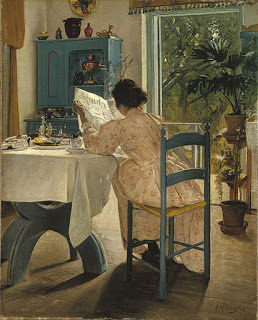 Breakfast Links are served - our weekly round-up of fav links to other web sites, articles, blogs, and images via Twitter.
Breakfast Links are served - our weekly round-up of fav links to other web sites, articles, blogs, and images via Twitter.• When booklovers guarded their prized possessions with tiny works of art.
• Were the Victorians healthier?
• Frolicsome engines: the long prehistory of artificial intelligence .
• Expenses , 1774: the cost of living and the cost of giving.
• Egyptian mummies in tartan?
• Medieval "proof" that Star Wars happened (maybe).
• Walking and skipping: how Edwardian footballers trained.
• Image: When a lady is corseted and nature calls....
• Duart Castle: the turbulent history of the ancestral home of Clan Maclean.
• Fearless photographs of the first tornado chasers , 1890s.
• These shoes once stomped out the rhythm of Los Angeles.
• Is Thomas Jefferson the most over-rated of the Founding Fathers?
• A 19thc map of our "square and stationary" Earth .
• Saucy escort cards were a way to flirt in Victorian era.
• Punch and Judy still live on in London's Covent Garden.
• Image: Cancan boots, c1900-1920.
• A 1900 advertisement for bicycles for women made a daring claim.
• Medieval textiles : Italian silks and velvets.
• "That country is my country": Loyalism and 18thc maps of British America.
• Rate this 1860s dress and all its flowers and swags.
• Napoleon's napkin from the Island of Elba, 1815.
• Bathing in an age of extravagance: make your own 17thc scented washball .
• Image: New rates for traveling the Thames in 1803.
• A forgotten plague: making sense of medieval dancing mania .
• A bottle with a message tossed into the sea in 1906 is finally recovered.
• Canoeing fashion in 1903 and the United States Postal Service.
Hungry for more? Follow us on Twitter @2nerdyhistgirls for fresh updates daily.
Above: At Breakfast by Laurits Andersen Ring. Private collection.
Published on May 07, 2016 14:00
May 5, 2016
Friday Video: The Countess di Castiglione, Queen of the Selfies
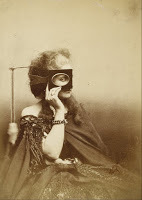 Scherzo di Follia (1863-66)
Loretta reports:
Scherzo di Follia (1863-66)
Loretta reports:A couple of days ago, my husband sent me a link to some photographs of an Italian countess I’d never heard of. She turned out to be well worth hearing about.
Virginia Oldoini, Countess of Castiglione, loved having her picture taken—under her command. As a result, we have a photographic treasure trove of mid-Victorian fashion and costume worn by a woman who upends our ideas of what “Victorian” mean.
But then, she was Italian.
I'm not going to tell her story here, because you can read all about her at Wikipedia and especially in this article at Mashable , which includes some splendid photos made under her direction (thus the "selfie" of this post title).
Instead I offer a video. I turned down the music, because it seemed a little overwrought for the subject. You may feel otherwise.
Image: Scherzo di Follia (1863-66)
Clicking on the image will enlarge it. Clicking on the caption will take you to the source, where you can learn more and enlarge images as needed.
Readers who receive our blog via email might see a rectangle, square, or nothing where the video ought to be. To watch the video, please click on the title to this post.
Published on May 05, 2016 21:30
May 4, 2016
"The Opening of the Great Exhibition by Queen Victoria on 1 May 1851"
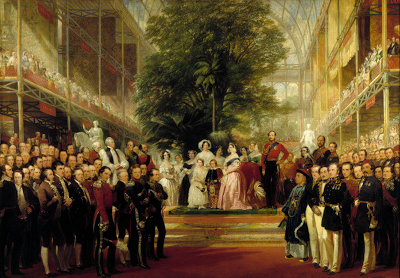
Isabella reporting,
When newsworthy events happen today, the rest of the world is instantly informed by television and social media. Images can become part of our shared consciousness almost as soon as they occur - sometimes even while they're occurring.
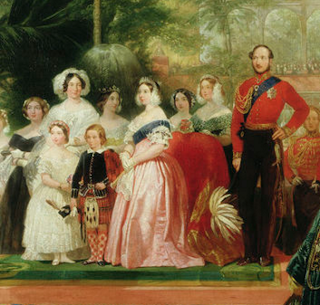 Things worked a bit more slowly 165 years ago. In the spring of 1851, the most important event in London was the opening of the International Exhibition of Arts and Manufacture - more customarily (and concisely) known as the Great Exhibition - in the enormous Crystal Palace in Hyde Park. Initiated by Prince Albert, the Exhibition was an early "tech show," showcasing the best manufactured examples of imagination and ingenuity from around the world.The not-so-subtle message, however, was that the creations of Great Britain were hands-down the best in the world, and so the exhibition became as much a tribute to the British Empire as it was to international excellence. Even the Crystal Palace itself was an architectural triumph, a marvel of British engineering.
Things worked a bit more slowly 165 years ago. In the spring of 1851, the most important event in London was the opening of the International Exhibition of Arts and Manufacture - more customarily (and concisely) known as the Great Exhibition - in the enormous Crystal Palace in Hyde Park. Initiated by Prince Albert, the Exhibition was an early "tech show," showcasing the best manufactured examples of imagination and ingenuity from around the world.The not-so-subtle message, however, was that the creations of Great Britain were hands-down the best in the world, and so the exhibition became as much a tribute to the British Empire as it was to international excellence. Even the Crystal Palace itself was an architectural triumph, a marvel of British engineering.While over six million people visited the Exhibition between 1May and 11 October, 1851, there were still many more, unable to attend, who wished a glimpse at its wonders. Artists of the day were quick to capture the Crystal Palace and the various exhibits, and while they couldn't post the images on Instagram or Facebook, they swiftly did produce prints of their work that were sold around the world.
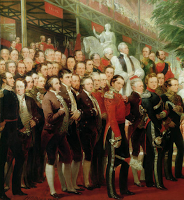
The painting shown above was made by Henry Courtenay Selous (1803-1890), and shows the opening day festivities. Of course the Royal Family (above left) is the centerpiece of the composition, but the Archbishop of Canterbury is also there, offering a benediction, as well as many of the dignitaries connected with the exhibition, right. (Except for Queen Victoria and her ladies, these are all male; other women appear to have been relegated to the viewing stands on either side of the ceremony, lower left, the curving brims of their bonnets framing their faces like scallop shells) In the foreground, the dignitaries are all carefully painted portraits, their presence documented.
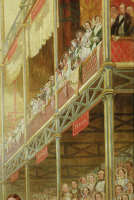
For that, really, was the purpose of a commemorative painting like this: to preserve an important historical moment for posterity. The painting became an event in its own right, and was publicly exhibited for an admission fee in the year after the exhibition had closed. The large scale of the painting - it's over ten feet wide - meant that details could be studied and appreciated equally by those who had attended the opening and those who had not. In addition, prints were produced and sold commercially, making this one of the most popular and best-known images of the exhibition.
A reviewer in the Art Journal in August 1852 proclaimed: "[This painting] will form an interesting memorial of an event that for many years to come will lose little of its attractiveness in the estimation of thousands." It still does.
The Opening of the Great Exhibition by Queen Victoria on 1 May 1851, by Henry Courtney Selous, 1851-1852. Victoria & Albert Museum.
Published on May 04, 2016 21:00
May 2, 2016
Fashions for May 1842
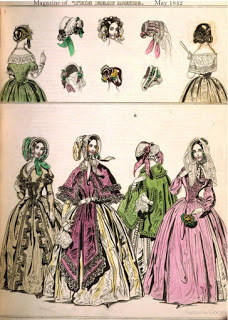 1842 Fashions
Loretta reports:
1842 Fashions
Loretta reports:Let me just say at the outset that finding good images for the 1840s is a bear. While I’ve located a number of magazines online, color plates are not abundant, and the scan quality of many is less than ideal. And I do wish the women didn’t wear such simpering expressions.
The poor quality may be the fault of the paper used in the magazines. There was a shift from rag paper to paper paper at some point in the Victorian era, and rag doesn’t deteriorate as easily as paper. As to the simpering expressions, I can come up with a couple of explanations: (1) the artists weren’t good with faces or (2) this is the way the ideal woman was supposed to look: sweet and not too intelligent.
In any case, I think this plate will explain why I refer to the early-to-mid Victorian look as droopy. Remember those wild and crazy hairdos of the 1820s and 1830s? Gone.
Hair is now slicked down on top, with the curls and braids and other artistic inventions relegated to the back of the neck. But that’s a sexy place, especially when the lady is wearing evening dress, with shoulders bared and bosom exposed in a way that seems not at all prudishly Victorian.
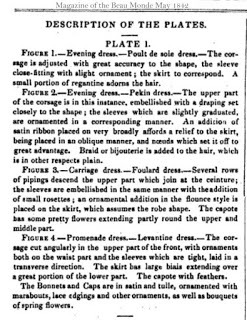 1842 Fashion Description
1842 Fashion Description
In any case, I think these dresses are very pretty. Notice that while the skirts are full, they haven’t yet yet attained the room-filling, knocking-over-tables-and-small-children width of the 1860s.
Images from The Magazine of the Beau Monde for May 1842
Clicking on the image will enlarge it. Clicking on the caption will take you to the source, where you can learn more and enlarge images as needed.
Published on May 02, 2016 21:30
May 1, 2016
From the Archives: Men (and Women) Behaving Badly: May Poles
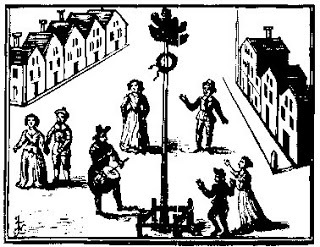 Isabella reporting:
Isabella reporting:We've just begun the merry month of May Day and May poles. While most of us today think of May poles with school children clutching the ribbons, that sweetly pretty version is a Victorian invention. Earlier May poles were much less innocent, with pagan antecedents so distant that no one knows exactly when the first was, ahem, erected.
But there's no mistaking their symbolism: a phallic pole firmly planted in Mother Earth, part of the annual celebration of fertility, procreation, and returning spring. Most May Rites were in that spirit, too, with much drinking and bawdy carousing. Puritanical Christians were appalled, as this description from Anatomy of Abuses (1583) by conservative pamphleteer Philip Stubbs (c.1555-1610) attests:
"All the young men and maids, old men and wives, run gadding over night to the woods, grove, hills, and mountains, where they spend all the night in pleasant pastimes; and in the morning they return, bringing with them...their May pole, which they bring home with great veneration, as thus: they have twenty or forty yoke of oxen, every ox having a sweet nose-gay of flowers placed on the tip of his horns, and these oxen draw home this May pole (this stinking idol, rather) which is covered allover with flowers and herbs, bound round with strings, from the top to the bottom, and sometimes painted with variable colours, with three hundred men, women, and children following with great devotion. And thus being reared up...they fall to dance about it, like as the heathen people did at the dedication of the Idols....I have heard it credibly reported (viva voce)...that of forty, three-score, or a hundred maids going to the wood over night, there have scarcely the third part of them returned home again undefiled. These be the fruits with which these cursed pastimes bring forth."
Could there be any coincidence that May with its May pole and night-long "gadding" is soon followed by June, the traditional month of weddings?
Above: The May-pole Dance, c. 1620. While there are many written descriptions of 17th c. May poles, both in their favor and against them, this demure illustration is the only contemporary one that I could find. Perhaps all the artists were too busy running into the woods?
Published on May 01, 2016 17:36
April 30, 2016
Breakfast Links: Week of April 25, 2016
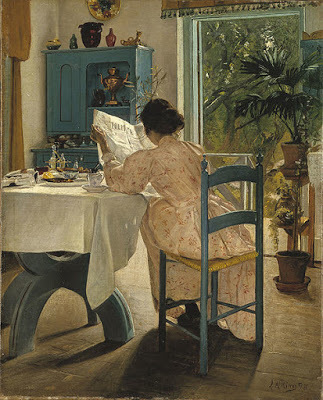 Breakfast Links are served - our weekly round-up of fav links to other web sites, articles, blogs, and images via Twitter.
Breakfast Links are served - our weekly round-up of fav links to other web sites, articles, blogs, and images via Twitter.• Ownership and imprints: famous hands and famous gloves .
• Even a genius has to sell himself: the remarkable resume of Leonardo daVinci .
• Wealthy boys from Eton who were accustomed to getting their own way: The Eton College Riot , 1818.
• "I don't know whether to kiss you or spank you": a half-century of fear of an unspanked woman .
• Image: 17thc blocks for printing playing cards .
• The golden age of the classic high heel : Ferragamo, Vivier, and the stiletto.
• The extraordinary life of Marianne North , Victorian explorer, naturalist, and painter.
• A history of virility , and why it's different (and maybe better than) mere manliness.
• Blue men, the bean-nighe, and a brownie: more mythical creatures of Scotland.
• Image: Postcard of American tourists in Europe, 1910.
• Why the colors you see in an art museum can't be replicated today.
• Why there's nothing vanilla about vanilla .
• An early 19thc church in Manhattan's Henry Street still retains its slave galleries.
• Painstaking portraits of 19thc dermatology patients .
• Image: Central dome of the 1889 Paris World's Fair Gallery of Machines - the world's largest interior space at the time.
• Could the Broadway smash Hamilton keep a woman's face off the $10 bill?
• The secret history of the Civil War photo at the center of the black confederate myth.
• Egyptian blue , the oldest known artificial pigment.
• Only a year after the San Francisco earthquake in 1906, Mrs. Irwin wears an " earthquake costume " to a party.
• A tale of two 18thc patriots from Salem, MA.
• For an editor in 1800, the best way to document a brutal local murder was to publish an epic poem about the crime.
• Image: Good luck using this 19thc tax calculator.
• Long (but interesting!) read: conversations and chimney-pieces: the role of the hearth in 18thc British portraiture.
• Watch 65 of Charlie Chaplin's films free online.
• Presidential inaugurations : national unity and partisan poking.
• Is Longfellow's famous poem about Paul Revere's ride really a call to 19thc abolitionists?
Hungry for more? Follow us on Twitter @2nerdyhistgirls for fresh updates daily.
Above: At Breakfast by Laurits Andersen Ring. Private collection.
Published on April 30, 2016 14:00
April 28, 2016
2NHG Signing Books in Burlington, MA
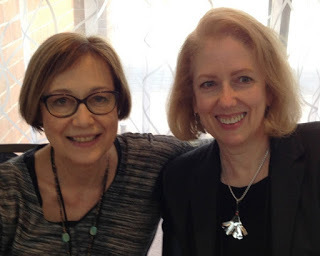 Loretta & Isabella report:
Loretta & Isabella report:There we were, at last year's book signing.
We'll be there again.
Loretta & Isabella
aka Two Nerdy History Girls
will, once again, be signing their books
in Burlington MA.
Open to the public.
Details below—with thanks to Penny Watson of NEC/RWA for posting a lovely image for me to steal.
 Hope to see you there!
Hope to see you there!
Published on April 28, 2016 21:30
April 25, 2016
What's Old is New: Double Rings
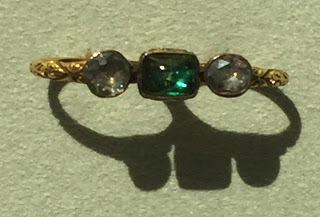 Isabella reporting,
Isabella reporting,Among the hottest trends in jewelry right now are double rings - rings whose designs span two fingers. It's considered a look that's new, hot, fresh, and very 2016.
So even though I know that there's nothing new under the sun, I was surprised when I saw this ring, upper left, last week at the Metropolitan Museum of Art. The shadow reveals the two rings beneath the three stones, and the black-and-white photo, right, from the museum's web site shows the joined rings more clearly.
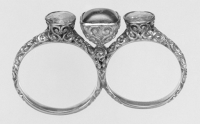
Featuring an emerald flanked by two rose-cut diamonds set in gold, the double ring was made in New York in 1895 by the well-regarded jewelry firm of Marcus & Company. The company's founder, Herman Marcus (1828-1899), was known for taking inspiration from the past for his designs, and this ring is in the Renaissance revival style popular at the time. So very 1895, by way of the 16th century.
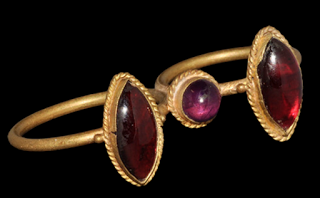
But it turns out that the design is even older than that. A little more investigation, and I learned that the double ring design dates back at least to the 1st century BC, when the ring, lower right, was made in Hellenistic Greece. With an amethyst flanked by two garnets set in twisted bezels, this gold ring would be right in style today. Proving that, once again, what's old (even very old!) is new again.
Above: Double ring, Marcus and Company, 1895, Metropolitan Museum of Art. Top left photography ©2016 Susan Holloway Scott.
Below: Hellenistic Greek gold double ring, 2nd-1st century. Private collection; image via TimeLine Auctions.
Published on April 25, 2016 21:00
April 24, 2016
Shakespeare's Buildings, Lost, Found, Recreated
 William Shakespeare-Chandos Portrait
Loretta reports:
William Shakespeare-Chandos Portrait
Loretta reports:Shakespeare’s birthday is 26 April, but since this is my day to post, we celebrate a day early.
I had a chance to experience a Shakespeare play in something close to what it might have been like when he was alive. A few years ago, we were in England, and had, for once, made reservations sufficiently far in advance to see one of the Bard’s works at the recreated Globe Theatre .
Though it represents an educated guess at what the original Globe was like, it seemed an authentic enough experience to me. At one point in the performance of Much Ado About Nothing, it started raining. Those standing under the open roof pulled up their rain hoods or umbrellas or simply got rained on.
It was an altogether different experience from watching a performance in a closed theater, or even at an outdoor theater. For one thing, the playhouse is small, and the audience is practically mingling with the players. All in all, it was a fabulous experience, and I hope to return next year.
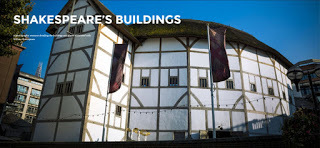 The Globe
That was one reason I became so intrigued when an email message invited me to look at
this beautiful series of Shakespeare-related photographs
—including some fine shots of the
recreated Globe Theatre
—and I learned about the discovery, by members of the
Museum of London Archaeology
, of the
Curtain Theatre
, where it’s believed some of Shakespeare’s plays made their debuts.
The Globe
That was one reason I became so intrigued when an email message invited me to look at
this beautiful series of Shakespeare-related photographs
—including some fine shots of the
recreated Globe Theatre
—and I learned about the discovery, by members of the
Museum of London Archaeology
, of the
Curtain Theatre
, where it’s believed some of Shakespeare’s plays made their debuts.The Curtain is going to be a centerpiece, interestingly enough, of a luxury development. You can find out more here and here .
There’s more about the Curtain Theatre at the MOLA site, and you can learn more about MOLA on their blog .
Images: Shakespeare, Chandos portrait , National Portrait Gallery via Wikipedia.
The Globe Theatre courtesy Shakespeare's Buildings
Clicking on the image will enlarge it. Clicking on the caption will take you to the source, where you can learn more and enlarge images as needed.
Published on April 24, 2016 21:30
April 23, 2016
Breakfast Links: Week of April 18, 2016
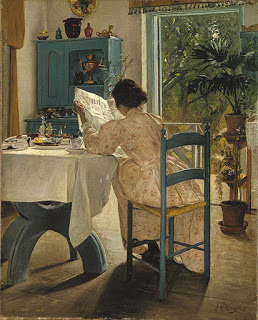 Breakfast Links are served - our weekly round-up of fav links to other web sites, articles, blogs, and images via Twitter.
Breakfast Links are served - our weekly round-up of fav links to other web sites, articles, blogs, and images via Twitter.• What is dazzle , and how did it influence 20thc fashion?
• "Deserved and received respect": how after twenty-four years as a female, Deborah Lewis transformed into the male Francis Lewis in 18thc Massachusetts.
• Image: Tiles with instructions for gymnastic exercises for young girls, 1840.
• D-Day hero set to marry his first love - 72 years after he first proposed to her.
• Poignant 19thc petitions from mothers hoping to find sanctuary for their illegitimate children.
• A 17thc silk gown with possible royal Stuart connections discovered off the Dutch coast.
• Extreme longevity in the 1700s.
• After centuries of innovation, is the library card dying?
• The sound of the past: Wheatley's Cries of London .
• Image: Warning sign at Yosemite National Park, 1915 - not that it stopped the people on that rock!
• On the trail of the Last Supper .
• Why the hit musical Hamilton is a potent reminder that historians are not the only custodians of history.
• Previously unknown Shakespeare First Folio discovered just lying around a grand Scottish home.
• A shot in the dark? A mysterious find in a bundle of archived papers.
• Image: Tax avoidance, 17thc style: a house built over a river between two jurisdictions.
• The tragic love story of children's illustrator and author Beatrix Potter.
• Lady Hamilton as a bacchante, restored and rediscovered.
• The life of a movie costume after filming is done.
• "Beware of the lascivious tango ", warned the Ladies' Home Journal, and these are the boots to prove why.
• Image: Nineteenth century Coca cola contained cocaine, and doctors prescribed it as a "nerve stimulant."
• Where's a witch to rest? Chimney stacks and witches' seats.
• Historical socks and stockings from the Nordiska Museet, Stockholm.
• George Washington's troublesome teeth .
• Image: Fantastic 18thc Polish pulpit .
• William Kidd, the pirate who was framed.
• Book quiz: do you know these last lines of famous novels?
Hungry for more? Follow us on Twitter @2nerdyhistgirls for fresh updates daily.
Above: At Breakfast by Laurits Andersen Ring. Private collection.
Published on April 23, 2016 14:00



